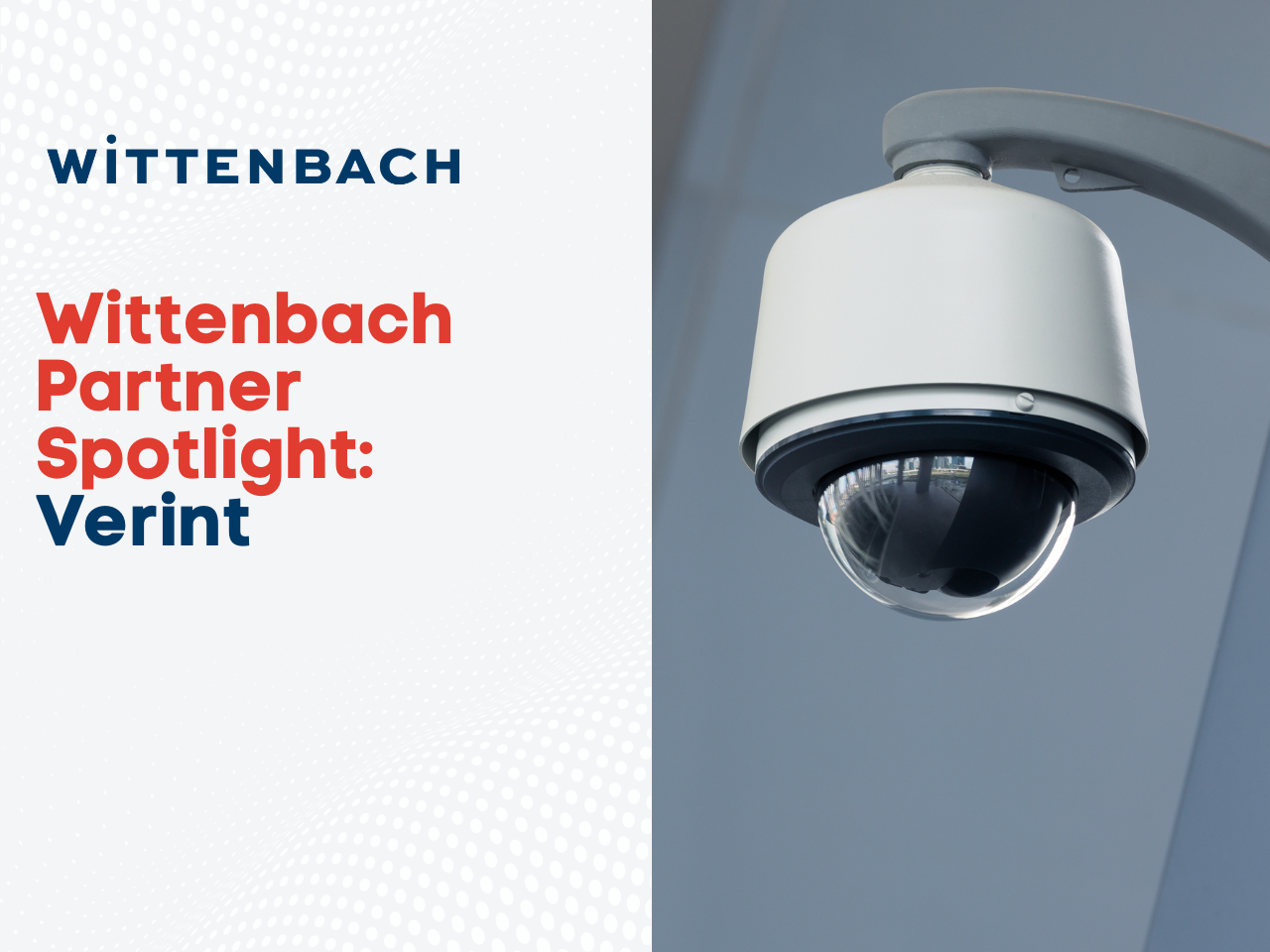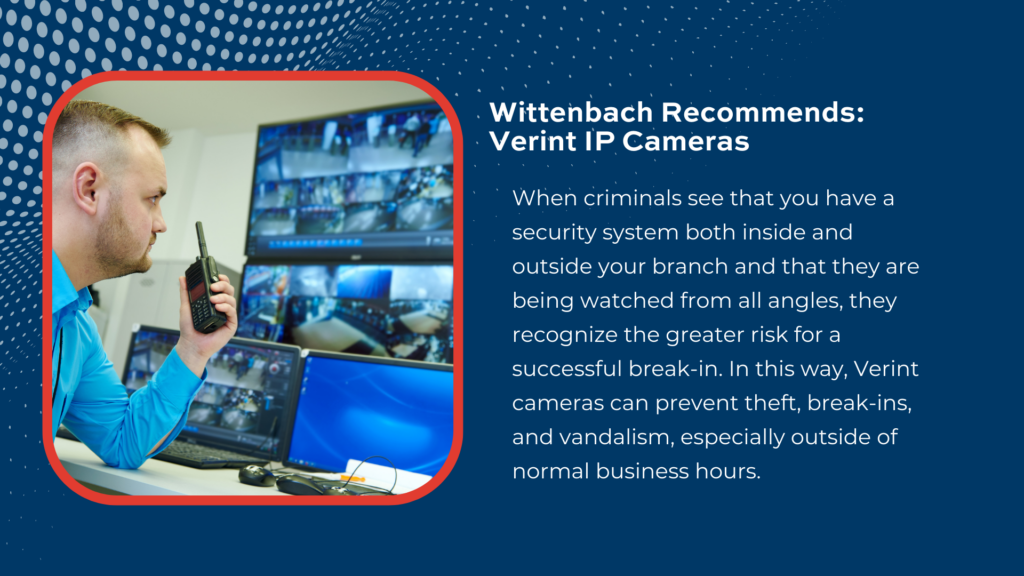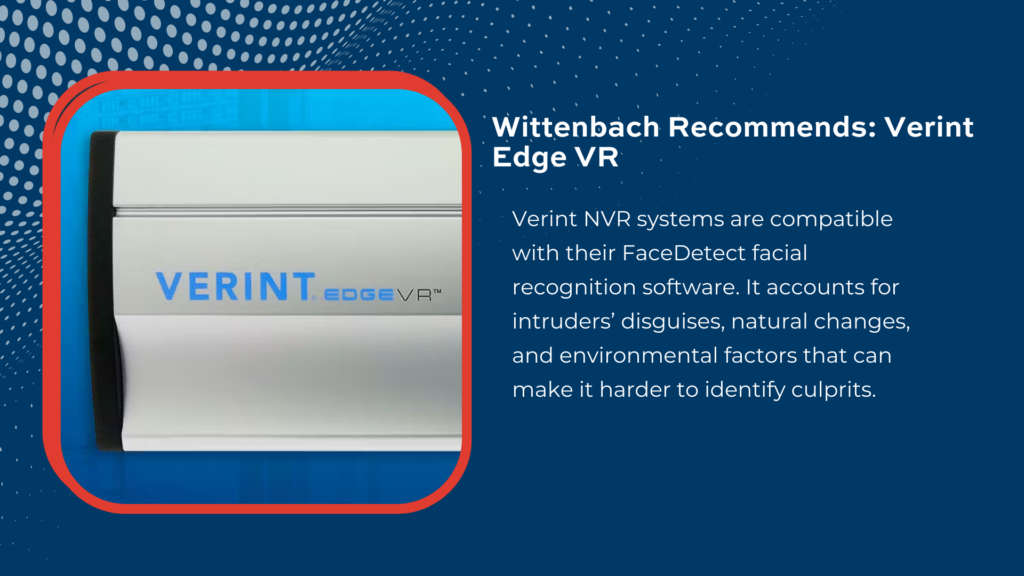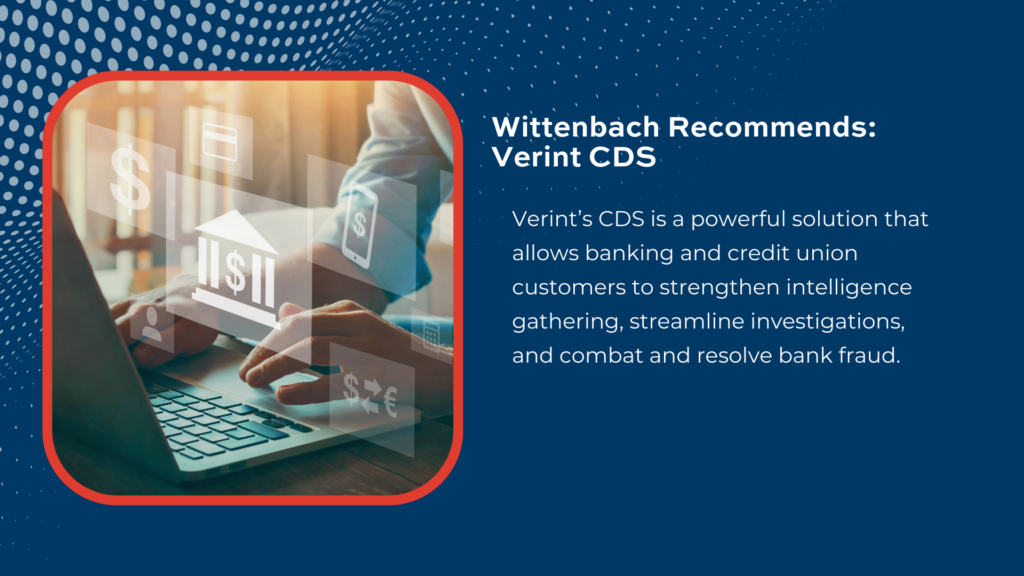Surveillance is a crucial element of a comprehensive electronic security infrastructure at a bank, credit union or financial institution, to protect your employees, clients, assets and property around the clock. The DVR, or digital video recorder, has long been regarded as a standard security system for banks and credit unions. Today, NVRs, or network video recorders, are displacing the DVR and setting a new standard for surveillance in banks and credit unions.
In this partner spotlight, you will learn more about Wittenbach’s cutting edge partner, Verint, and the products we recommend for upgrading your surveillance, or as part of a branch transformation plan.
Important Aspects of Surveillance Security Technology
First, it is important to understand the role surveillance plays in electronic security. Surveillance security technology is defined as a combination of recording devices, aimed to capture activity at a specific location. These recording devices can record pictures, video, audio, or a combination of any of these factors. The three major components of a surveillance system are cameras, video recorder equipment, and a monitoring solution or service. While DVR systems require analog cameras, NVR systems use IP cameras. IP cameras are more flexible and can be connected to the cloud.
For the purposes of this partner spotlight on Verint, we will explore in greater detail, the features of cameras and video recording equipment:
Cameras
Cameras are critical to the visual data intake portion of an electronic surveillance system. CCTV cameras, otherwise known as closed-circuit television cameras, were frequently used in the past. Today, IP cameras, otherwise known as internet protocol cameras, are the more popular choice, because of their efficacy and innovative features. These recording devices offer high-resolution video recording, and the footage they capture can be transferred to a local network storage device. This makes it easy to keep track of videos in a safe place, for either immediate or later viewing. It is also possible to store ongoing video capture directly on the cloud, where it can be saved and distributed to the necessary parties via virtually any device. Contrary to common thinking, IP cameras do not require internet connection. Instead, they just need to be connected to a local network.
Video Recorder Equipment
Video recorder equipment is another important aspect of surveillance security technology. Cloud security company Solink explains that on the surface, both NVR and DVR systems serve the same purpose: they capture video footage transmitted from the cameras and store that stream so you can play it back later. The main difference between DVR and NVR systems is how they communicate and transmit video data.
DVR Video Data Transmission
DVR security systems use analog cameras to pass raw feed to a recorder via coaxial cables. The recorder then processes and stores the video. A simpler product than the NVR system, the presence of a DVR still helps your branch meet legal security requirements, and it can successfully deter theft and break-ins. The cost of replacing a DVR analog camera is also much lower than an NVR, and these can typically be interchangeable with any brand; however, you must have a separate power source as analog cameras cannot power themselves.
On the downside, DVR systems–and especially their older cameras–have a much lower resolution than NVRs, often losing definition such as faces and license plates during security incidents, which could impact the outcome of a security incident at your branch.
NVR Video Data Transmission
An NVR does not record footage on its own. It receives footage and stores it for viewing at a later date or time. An NVR can store the footage it receives on an internal hard drive, or it can store footage off-site through the use of the cloud. If using the cloud, NVRs allow the users to view the footage anywhere, even remotely. NVRs and IP cameras work together and are a natural evolution of the technology used within DVR technology, or digital video recorders. This technology was originally used to capture images and video footage from CCTV cameras.
Why Upgrade to NVR Systems?
NVR camera systems can be as small as one camera or span across thousands of cameras in multiple locations globally. Indoor and outdoor cameras can be positioned in various places around buildings and properties. They usually operate continuously – 24/7 – and can be customized to alert in response to certain activity during specific times of day and offer:
- Increased security: network video recorders can exist virtually anywhere in your branch; as they aren’t wired, cameras can be located in places they couldn’t be before.
- Poised for innovation: the future of surveillance is NVRs over DVRs and are essential for branch transformation.
- Cost-effective across locations: you will see a quicker return on your investment by installing multiple NVR security systems at a time.
Wittenbach Partner Spotlight: Verint
When choosing an electronic surveillance system, there are a number of different factors to consider, including cost, maintenance, ease of installation, and areas in which the system is needed. Different security measures work well in different situations.
Below we explore three Verint products as premier options for electronic surveillance.
1. Verint IP Cameras
First, regarding recording equipment, we recommend utilizing Verint IP cameras, which are top-of-the-line. These cameras are available in numerous different models, and vary depending on location and use.
According to The Zebra, external cameras were listed as the most important feature to have in a security system. Many of Verint’s cameras can be used inside or outside:
- For example the EVO 05 Mini is a small, compact camera that can be installed indoors or outdoors.
- Another option, the ONCAM C-12, offers 360-degree viewing, and can also be used both outside and inside. It also has advanced light management features, which can be useful.
- The 8080FDW-DN model is most effective in low-light, outdoor conditions, due to its dome shape.
When criminals see that you have a security system both inside and outside your branch and that they are being watched from all angles, they recognize the greater risk for a successful break-in. In this way, Verint cameras can prevent theft, break-ins, and vandalism, especially outside of normal business hours.
Verint cameras not only deter criminals, they can help catch intruders, too. If someone breaks in, vandalizes your property, or attempts a theft, your Verint NVR system can capture it all. In a previous blog post, we discussed how Verint NVR systems are compatible with their FaceDetect facial recognition software. It accounts for intruders’ disguises, natural changes, and environmental factors that can make it harder to identify culprits.
2. Verint EdgeVR Series
When it comes to NVR technology, we recommend the Verint EdgeVR series.
This series includes reliable NVRs with many storage solutions for video, such as:
- The Verint EdgeVR 300 – designed for large-scale implementations and can accommodate 64 IP and analog video cameras.
- The Verint EdgeVR 80 – slightly smaller operation in mind, accommodating up to 12 cameras at once (including analog, IP, and megapixel cameras.)
- The Verint EdgeVR 60 – seamlessly integrates with Verint’s own IP cameras, and its smaller size allows this security system to fit in places that others may not.
3. Verint’s Central Data Services (CDS)
Other Verint software offerings can support your institution’s transformation, such as Verint’s Central Data Services (CDS). Verint’s CDS is a powerful solution that allows banking and credit union customers to strengthen intelligence gathering, streamline investigations, and combat and resolve bank fraud.
In summary
Electronic surveillance security is one aspect of a holistic security plan or branch transformation. Regardless of which products you choose, it is important to work with a trusted partner who understands your unique needs. Wittenbach has nearly fifty years of experience in helping to put together the right electronic and physical security products and solutions for banks, credit unions, financial institutions and more. No matter the scope and scale of your electronic security footprint, we can frame out an effective security plan. Contact us for a consultation or schedule a tour.




